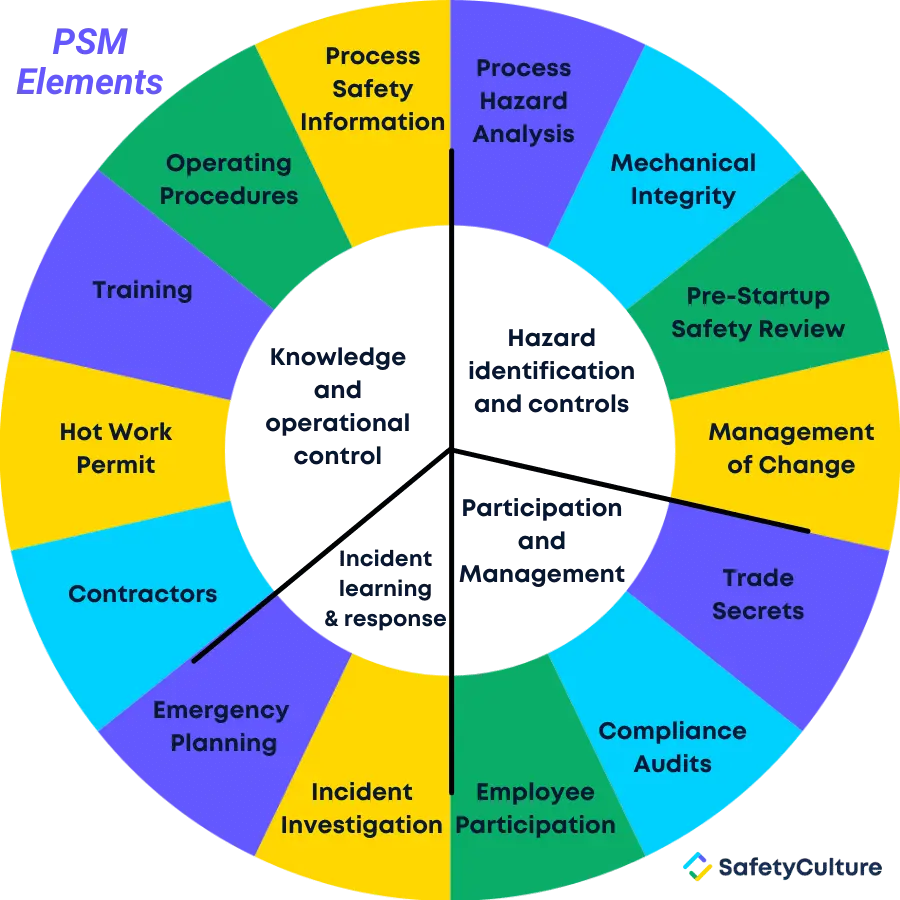What is Process Safety Management?
Process Safety Management (PSM) is an Occupational Safety and Health Administration (OSHA) regulatory standard designed for processes involving Highly Hazardous Chemicals (HHCs). The OSHA process safety management standard includes requirements for preventing catastrophic releases of toxic, reactive, flammable, or explosive chemicals. While the full list of HHCs can be found in Appendix A of the OSHA PSM standard, it might also be helpful for chemical safety managers to know the basic definitions of toxic, reactive, flammable, and explosive. These are properties or characteristics of HHCs.
According to the Center for Chemical Process Safety (CCPS):
- Toxic Material – an airborne agent that could result in acute adverse human health effects
- Reactive Material – a substance which enters into a chemical reaction with other stable or unstable material
- Flammable – a gas that can burn with a flame if mixed with a gaseous oxidizer such as air and then ignited
- Explosive – a chemical that causes a sudden release of pressure, gas, and heat when subjected to sudden shock, pressure, or high temperature
Why Is Process Safety Management Important?
One of the reasons why OSHA decided to create PSM is the Phillips disaster of 1989. In October of that year, an explosion and fire at the Phillips 66 Company’s Houston Chemical Complex (HCC) took the lives of 23 workers and injured 132 others. The event also resulted in $750,000,000 worth of property damage and a $4,000,000 fine issued by OSHA.
However, even after OSHA had released the PSM standard in 1992, another disaster occurred at the BP Texas City refinery in 2005, leading to the deaths of 15 workers and 180 others injured. The company had to pay $2,000,000,000 to the victims of the disaster and their relatives as compensation. Repairs and lost profits also cost BP over $1,000,000,000.
What Falls Under the PSM Standard and What Doesn’t
OSHA states that the process safety management standard applies to any process that involves a chemical with quantities at or above the specified threshold listed in Appendix A and any process that involves a Category 1 flammable gas or a flammable liquid with a flashpoint below 100 °F (37.8 °C) and in a quantity of 10,000 pounds (4535.9 kg) or more.
Compliance with PSM is not required when hydrocarbon fuels are used solely for workplace consumption and when flammable liquids are kept below their normal boiling point. PSM also does not apply to retail facilities, oil or gas well drilling or servicing operations, and normally unoccupied remote facilities.
The 14 PSM Elements
For organizations with processes that involve the use of HHCs, complying with process safety management is crucial, not only because it’s a legal requirement, but also because the consequences of non-compliance are devastating.
To prevent disasters such as the Phillips 1989 and the BP Texas City Refinery explosions, chemical safety managers need to ensure that each site has a process safety management program with all of the 14 elements.

1. Process Safety Information
Collect and document process safety information (PSI) regarding hazards, technology, and equipment. Hazard information should cover toxicity, exposure limits, physical and chemical properties, reactivity, stability, and risks of mixing materials. If safety data sheets comply with OSHA standards, hazard information is considered met. Technology information should include diagrams, chemistry details, inventory limits, and consequences of deviations. Equipment information entails construction materials, diagrams, safety systems, and design standards.
2. Operating Procedures
Develop and implement operating procedures on how to safely proceed with the activities and tasks involved in the process. Operating procedures should be aligned with PSI and address the steps for each operating phase, operating limits, safety and health considerations, and safety systems and their functions.
Aside from PSI on hazards, other safety and health considerations are the precautions necessary to prevent exposure, control measures in case of exposure, quality control for raw materials, and control of hazardous chemical inventory levels.
3. Process Hazard Analysis
A process hazard analysis (PHA) evaluates process hazards, considering past incidents, control measures, and potential consequences of failures. It requires a specialized team comprising experts in engineering, process operations, and PHA methodologies. PHA methodologies include what-if scenarios, checklists, HAZOP, FMEA, and fault tree analysis. PHAs, a vital part of process safety management, must be updated and revalidated every five years.
Improve your EHS Management
Cultivate a safe working environment and streamline compliance with our EHS solutions.
Explore now4. Employee Participation
Before proceeding with the other elements, chemical safety managers will need to develop a plan of action on implementing employee participation in the PSM program. Additionally, chemical safety managers must consult with employees on how to proceed with each element as well as provide access to information relevant to the program.
5. Training
Aside from participating in the PSM program, employees should receive adequate training on the process, operating procedures, emergency operations, specific safety and health hazards, and safe work practices. Chemical safety managers should also conduct refresher training at least every 3 years, or more often if necessary.
All training must be documented and include the identity of the employee, the date of training, and verification that the employee understands the subject matter of the training.
6. Contractors
This PSM element applies to contractors performing maintenance or repair, turnaround, major renovation, and specialty work. Chemical safety managers should review the contractor’s safety performance and programs before selecting them.
After selection, chemical safety managers must periodically evaluate the performance of the chosen contractor. They should also consider giving the contractor’s employees a site induction to brief them on the potential hazards related to the work, process, or site.
7. Mechanical Integrity
Ensure the mechanical integrity of process equipment, including pressure vessels, storage tanks, piping systems, pumps, and monitoring systems. Document inspections and tests conducted, rectifying any deficiencies beyond acceptable limits before further use. Utilize tracking tools or software to monitor equipment status, promptly addressing any issues to prevent accidents.
8. Incident Investigation
A PSM incident involves or could potentially result in a catastrophic release of a hazardous chemical. Chemical safety managers must begin an investigation within 48 hours of such an incident, identifying its primary cause and contributing factors, along with recommendations for prevention. Prompt action should follow to address findings and implement corrective measures from the investigation report. Once resolved, all affected parties should review the report thoroughly to determine the need for further investigation.
9. Management of Change
Before making any changes to chemicals, technology, equipment, or facilities, prepare a management of change (MOC) procedure. It should address the technical basis for the proposed change, its impact on safety and health, modifications to operating procedures, and the authorization requirements and time period needed for the proposed change.
10. Pre-Startup Safety Review
For new and modified facilities, chemical safety managers must perform a pre-startup safety review. The PSSR should confirm that construction and equipment are in accordance with design specifications, operating procedures have been established, and all employee training is complete. Additionally, there must be a MOC procedure for modified facilities and a PHA has to be performed for new facilities.
11. Emergency Planning and Response
Develop an emergency action plan (EAP) for the entire site. It should meet the requirements of the EAP OSHA standard and include procedures for handling small releases of HHCs. If the site is under the Hazardous Waste Operations and Emergency Response (HAZWOPER) OSHA standard, ensure that the EAP meets the requirements of that standard as well.
12. Hot Work Permit
A hot work permit is issued whenever hot work operations are conducted on or near a process. Before requesting or issuing a hot work permit, chemical safety managers must ensure that the fire prevention and protection requirements of the Welding, Cutting, and Brazing OSHA standard have been implemented. The hot work permit will verify this and also specify the date/s authorized for hot work and the object/s on which hot work is to be performed.
13. Compliance Audits
Chemical safety managers must conduct compliance audits at least every 3 years to check if the site’s PSM program adheres to all of the elements. They will also need to determine and document an appropriate response to each of the findings in the compliance audit reports. Organizations are required by the PSM standard to keep the two most recent compliance audit reports.
14. Trade Secrets
Without regard to possible trade secret status, all information necessary to comply with the PSM standard should be made available to those involved in the PSM program. However, organizations are allowed to require such persons to enter into confidentiality agreements not to disclose any trade secret information.



